
Geysers: The geyser Old Faithful in Yellowstone National Park alternates periods of eruption, which typically last from 1.5 to 4 minutes, with periods of dormancy, which are considerably longer. The following table presents the durations, in minutes, of 60 dormancy periods that occurred during a recent year.

- Construct a frequency distribution using a class width of 5, and using 55 as the lower class limit for the first class.
- Construct a frequency histogram from the frequency distribution in part (a).
- Construct a relative frequency distribution using the same class width and lower limit for the first class.
- Construct a relative frequency histogram.
- Are the histograms skewed to the left, skewed to the right, or approximately symmetric?
- Repeat parts (a)—(d), using a class width of 10, and using 50 as the lower class limit for the first class.
- Do you think that class widths of 5 and 10 are both reasonably good choices for these data, or do you think that one choice is much better than the other? Explain your reasoning.
a.
To construct:A frequency distribution using a class width of 5, and using 55 as the lower class limit for the first class.
Explanation of Solution
Given information:The following table presents the durations, in minutes, of 60 dormancy periods that occurred during a recent year.
| 91 | 99 | 99 | 83 | 99 | 85 | 90 | 96 | 88 | 93 |
| 88 | 88 | 92 | 116 | 59 | 101 | 90 | 71 | 103 | 97 |
| 82 | 91 | 89 | 89 | 94 | 94 | 61 | 96 | 66 | 105 |
| 90 | 93 | 88 | 92 | 86 | 93 | 95 | 83 | 90 | 99 |
| 89 | 94 | 90 | 95 | 93 | 105 | 96 | 92 | 101 | 91 |
| 94 | 92 | 94 | 86 | 88 | 99 | 90 | 99 | 84 | 92 |
Definition used: Frequency distributions for quantitative data are just like those for qualitative data, except the data are divided into classes rather categories.
Solution:
The class width is 5. The minimum and maximum values of the ratings are 55 and 119.9.
The table of frequency distribution is given by
| Dormancy period | Frequency |
| 55-59.9 | 1 |
| 60-64.9 | 1 |
| 65-69.9 | 1 |
| 70-74.9 | 1 |
| 75-79.9 | 0 |
| 80-84.9 | 4 |
| 85-89.9 | 11 |
| 90-94.9 | 23 |
| 95-99.9 | 12 |
| 100-104.9 | 3 |
| 105-109.9 | 2 |
| 110-114.9 | 0 |
| 115-119.9 | 1 |
b.
To construct:A frequency histogram from the frequency distribution.
Explanation of Solution
Given information:The table of frequency distribution is given by
| Dormancy period | Frequency |
| 55-59.9 | 1 |
| 60-64.9 | 1 |
| 65-69.9 | 1 |
| 70-74.9 | 1 |
| 75-79.9 | 0 |
| 80-84.9 | 4 |
| 85-89.9 | 11 |
| 90-94.9 | 23 |
| 95-99.9 | 12 |
| 100-104.9 | 3 |
| 105-109.9 | 2 |
| 110-114.9 | 0 |
| 115-119.9 | 1 |
Definition used: Histograms based on frequency distributions are called frequency histogram.
Solution:
The frequency histogram for the given data is given by
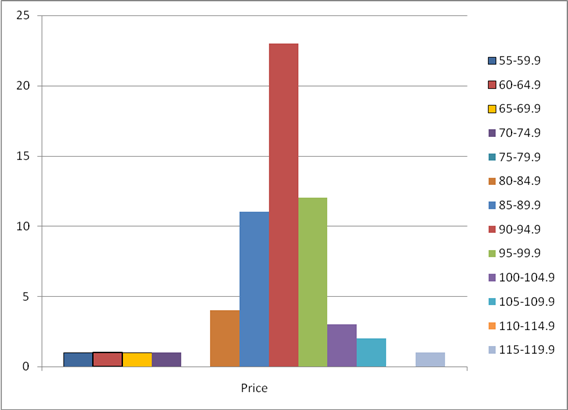
c.
To construct: A relative frequency distribution.
Explanation of Solution
Given information:The table of frequency distribution is given by
| Dormancy period | Frequency |
| 55-59.9 | 1 |
| 60-64.9 | 1 |
| 65-69.9 | 1 |
| 70-74.9 | 1 |
| 75-79.9 | 0 |
| 80-84.9 | 4 |
| 85-89.9 | 11 |
| 90-94.9 | 23 |
| 95-99.9 | 12 |
| 100-104.9 | 3 |
| 105-109.9 | 2 |
| 110-114.9 | 0 |
| 115-119.9 | 1 |
Formula used:
Solution:
From the given table,
The sum of all frequency is
The table of relative frequency is given by
| Dormancy period | Frequency | Relative frequency |
| 55-59.9 | 1 | |
| 60-64.9 | 1 | |
| 65-69.9 | 1 | |
| 70-74.9 | 1 | |
| 75-79.9 | 0 | |
| 80-84.9 | 4 | |
| 85-89.9 | 11 | |
| 90-94.9 | 23 | |
| 95-99.9 | 12 | |
| 100-104.9 | 3 | |
| 105-109.9 | 2 | |
| 110-114.9 | 0 | |
| 115-119.9 | 1 |
d.
To construct: A relative frequency histogram.
Explanation of Solution
Given information:The following table presents the durations, in minutes, of 60 dormancy periods that occurred during a recent year.
| 91 | 99 | 99 | 83 | 99 | 85 | 90 | 96 | 88 | 93 |
| 88 | 88 | 92 | 116 | 59 | 101 | 90 | 71 | 103 | 97 |
| 82 | 91 | 89 | 89 | 94 | 94 | 61 | 96 | 66 | 105 |
| 90 | 93 | 88 | 92 | 86 | 93 | 95 | 83 | 90 | 99 |
| 89 | 94 | 90 | 95 | 93 | 105 | 96 | 92 | 101 | 91 |
| 94 | 92 | 94 | 86 | 88 | 99 | 90 | 99 | 84 | 92 |
Definition used: Histograms based on relative frequency distributions are called relative frequency histogram.
Solution:
| Dormancy period | Relative frequency |
| 55-59.9 | 0.017 |
| 60-64.9 | 0.017 |
| 65-69.9 | 0.017 |
| 70-74.9 | 0.017 |
| 75-79.9 | 0.000 |
| 80-84.9 | 0.067 |
| 85-89.9 | 0.183 |
| 90-94.9 | 0.383 |
| 95-99.9 | 0.200 |
| 100-104.9 | 0.050 |
| 105-109.9 | 0.033 |
| 110-114.9 | 0.000 |
| 115-119.9 | 0.017 |
Therelative frequency histogram for the given data is given by
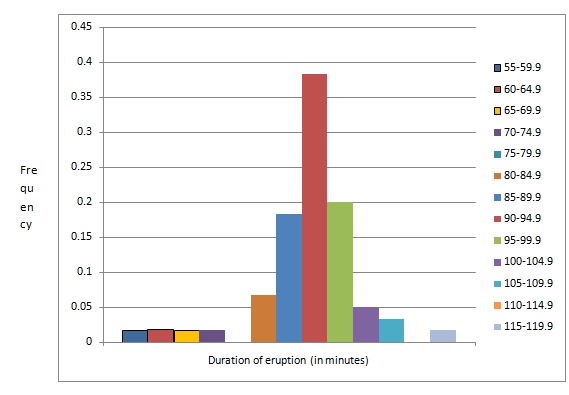
e.
To find: Whether the histograms are skewed to the right, skewed to the left , or approximately symmetric.
Answer to Problem 32E
The histogram is skewed to the left.
Explanation of Solution
Given information:The following table presents the durations, in minutes, of 60 dormancy periods that occurred during a recent year.
| 91 | 99 | 99 | 83 | 99 | 85 | 90 | 96 | 88 | 93 |
| 88 | 88 | 92 | 116 | 59 | 101 | 90 | 71 | 103 | 97 |
| 82 | 91 | 89 | 89 | 94 | 94 | 61 | 96 | 66 | 105 |
| 90 | 93 | 88 | 92 | 86 | 93 | 95 | 83 | 90 | 99 |
| 89 | 94 | 90 | 95 | 93 | 105 | 96 | 92 | 101 | 91 |
| 94 | 92 | 94 | 86 | 88 | 99 | 90 | 99 | 84 | 92 |
Definition used:
A histogram which has a long right-hand tail is said to be skewed to the right.
A histogram which has a long left-hand tail is said to be skewed to the left.
A histogram is symmetric if its right half is a minor image of its left half.
Solution:
The frequency histogram for the given data is given by
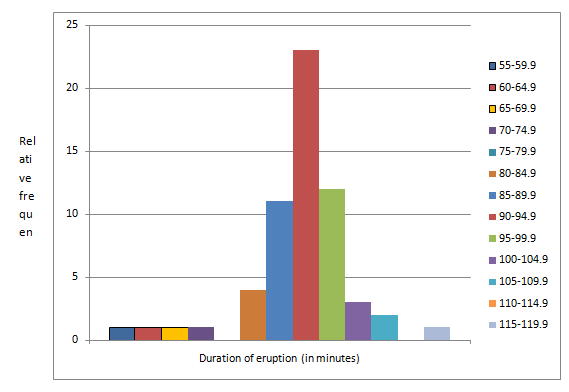
The above histogram has a long left-hand tail; therefore, it is skewed to the left.
Hence, the histogram is skewed to the left.
f.
To construct: A frequency distribution using a class width of 10, and using 50 as the lower class limit for the first class, a frequency histogram, relative frequency distribution and relative frequency histogram.
Explanation of Solution
Given information: The following table presents the durations, in minutes, of 60 dormancy periods that occurred during a recent year.
| 91 | 99 | 99 | 83 | 99 | 85 | 90 | 96 | 88 | 93 |
| 88 | 88 | 92 | 116 | 59 | 101 | 90 | 71 | 103 | 97 |
| 82 | 91 | 89 | 89 | 94 | 94 | 61 | 96 | 66 | 105 |
| 90 | 93 | 88 | 92 | 86 | 93 | 95 | 83 | 90 | 99 |
| 89 | 94 | 90 | 95 | 93 | 105 | 96 | 92 | 101 | 91 |
| 94 | 92 | 94 | 86 | 88 | 99 | 90 | 99 | 84 | 92 |
Solution:
The class width is 10. The minimum and maximum values of the ratings are 50 and 119.9.
The table of frequency distribution is given by
| Dormancy period | Frequency |
| 50-59.9 | 1 |
| 60-69.9 | 2 |
| 70-79.9 | 1 |
| 80-89.9 | 15 |
| 90-99.9 | 35 |
| 100-109.9 | 5 |
| 110-119.9 | 1 |
The frequency histogram for the given data is given by
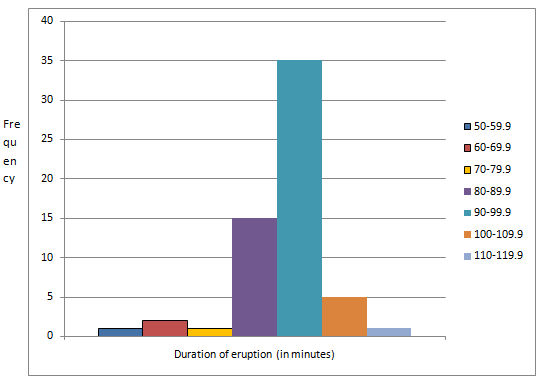
The sum of all frequency is
The relative frequency distribution table is given by
| Dormancy period | Frequency | Relative frequency |
| 50-59.9 | 1 | |
| 60-69.9 | 2 | |
| 70-79.9 | 1 | |
| 80-89.9 | 15 | |
| 90-99.9 | 35 | |
| 100-109.9 | 5 | |
| 110-119.9 | 1 |
The relative frequency histogram for the given data is given by
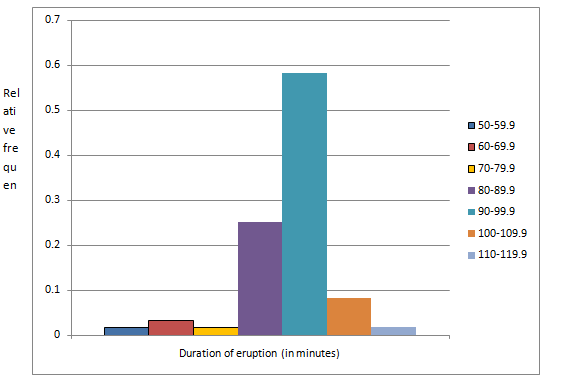
g.
To explain: Whether the good choices for the data are that class width of 5 or 10.
Answer to Problem 32E
Explanation of Solution
Given information:The following table presents the durations, in minutes, of 60 dormancy periods that occurred during a recent year.
| 91 | 99 | 99 | 83 | 99 | 85 | 90 | 96 | 88 | 93 |
| 88 | 88 | 92 | 116 | 59 | 101 | 90 | 71 | 103 | 97 |
| 82 | 91 | 89 | 89 | 94 | 94 | 61 | 96 | 66 | 105 |
| 90 | 93 | 88 | 92 | 86 | 93 | 95 | 83 | 90 | 99 |
| 89 | 94 | 90 | 95 | 93 | 105 | 96 | 92 | 101 | 91 |
| 94 | 92 | 94 | 86 | 88 | 99 | 90 | 99 | 84 | 92 |
The class width of 5 provides more appropriate level of detail in the middle of the histogram, but it is very sparse in the tail.
The class width of 10 is better in the tails, but most of the data are in only two classes.
Therefore, the distribution of class width of 5 is more reasonably good choice than class width of 10.
Want to see more full solutions like this?
Chapter 2 Solutions
Connect Hosted by ALEKS Online Access for Elementary Statistics
- The following table shows a data set containing information for 25 of the shadow stocks tracked by the American Association of Individual Investors (aaii.com, February 2002). Shadow stocks are common stocks of smaller companies that are not closely followed by Wall Street analysts. Click on the datafile logo to reference the data. DATA file Company DeWolfe Companies Exchange AMEX Ticker Symbol Market Cap Price/ Gross Profit Earnings Margin ($ millions) Ratio (%) DWL 36.4 8.4 36.7 North Coast Energy OTC NCEB 52.5 6.2 59.3 Hansen Natural Corp. OTC HANS 41.1 14.6 44.8 MarineMax, Inc. NYSE HZO 111.5 7.2 23.8 Nanometrics Incorporated OTC NANO 228.6 38.0 53.3 TeamStaff, Inc. OTC TSTF 92.1 33.5 4.1 Environmental Tectonics AMEX ETC 51.1 35.8 35.9 Measurement Specialties AMEX MSS 101.8 26.8 37.6 SEMCO Energy, Inc. NYSE SEN 193.4 18.7 23.6 Party City Corporation OTC PCTY 97.2 15.9 36.4 Embrex, Inc. OTC EMBX 136.5 18.9 59.5 Tech/Ops Sevcon, Inc. AMEX ΤΟ 23.2 20.7 35.7 ARCADIS NV OTC ARCAF 173.4…arrow_forwardThe following data show the year to date percent change (YTD % Change) for 30 stock-market indexes from around the word (The Wall Street Journal, August 26, 2013). a. What index has the largest positive YTD % Change? Round your answer to once decimal place. index with a YTD % Change of % b. Using a class width of 5 beginning with -20 and going to 40, develop a frequency distribution for the data. YTD % Change Frequency -20 - -15 -15 - -10 -10 - -5 -5 - 0 0 - 5 5 - 10 10 - 15 15 - 20 20 - 25 30 - 35 c. 1. 2. 3. 4.arrow_forwardThe following data show the year to date percent change (YTD % Change) for 30 stock-market indexes from around the word (The Wall Street Journal, August 26, 2013). Click on the datafile logo to reference the data. DATA file Country Australia Index S&P/ASX200 YTD % Change 10.2 Belgium Bel-20 12.6 Brazil São Paulo Bovespa -14.4 Canada S&P/TSX Comp 2.6 Chile Santiago IPSA -16.3 China Shanghai Composite -9.3 Eurozone EURO Stoxx 10.0 France CAC 40 11.8 Germany DAX 10.6 Hong Kong Hang Seng -3.5 India S&P BSE Sensex -4.7 Israel Tel Aviv 1.3 Italy FTSE MIB 6.6 Japan Nikkei 31.4 Mexico IPC All-Share -6.4 Netherlands AEX 9.3 Singapore Straits Times -2.5 South Korea Kospi -6.4 Spain IBEX 35 6.4 Sweden Switzerland SX All Share 13.8 Swiss Market 17.4 Taiwan Weighted 2.3 U.K. FTSE 100 10.1 U.S. S&P 500 16.6 U.S. DJIA 14.5 U.S. Dow Jones Utility 6.6 U.S. Nasdaq 100 17.4 U.S. Nasdaq Composite 21.1 World DJ Global ex U.S. 4.2 World DJ Global Index 9.9 a. What index has the largest positive YTD %…arrow_forward
- Describe a three step process you choose to determine how many elementary schools there are in the city of 5 million people.arrow_forwardQuiz: Exam 1 (Ch 1-4) z Scores Table-3.pdf x + edu/courses/308627/quizzes/2442507/take/questions/48957332 Canvas Hall It browser 5 Connect Set as default incorrect. • This exam is NOT resumable. Meaning, once you start the exam, you must complete it in its entirety. Any blank questions will be marked as By taking this exam, you agree to adhere to the academic integrity standards, which consist of NOT cheating in any way. To get the highest possible score, you are encouraged to review your notes before taking the exam. You may use your notes during the exam, but note that you should be familiar with the concepts and formulas before taking exam. z Scores Table.pdf Question 3 3 pts Here is a data from a survey asking young children how many hours they spend playing video games. The researchers reported the percent of boys and girls who played no games, less than 1 hour per day, 1-3 hours per day, or greater than 3 hours per day. The most common number of hours per day that boys played is…arrow_forwardWrite a Regression summary explaining significance of mode, explaining regression coefficients, significance of the independent variables, R and R square. Premiums earned Net income Dividends Underwriting Gain/ Loss 30.2 1.6 0.6 0.1 47.2 0.6 0.7 -3.6 92.8 8.4 1.8 -1.5 95.4 7.6 2 -4 100.4 6.3 2.2 -8.1 104.9 6.3 2.4 -10.8 113.2 2.2 2.3 -18.2 130.3 3.0 2.4 -21.4 161.9 13.5 2.3 -12.8 182.5 14.9 2.9 -5.9 193.3 11.7 2.9 -7.6arrow_forward
- 1- Let A = {A1, A2, ...), in which A, A, = 0, when i j. a) Is A a π-system? If not, which element(s) should be added to A to become a π-system? b) Prove that σ(A) consists of the finite or countable unions of elements of A; i.c., A E σ(A) if and only if there exists finite or countable sequence {n} such that A = U₁An (Hint: Let F be such class; prove that F is a σ-filed containing A.) c) Let p ≥ 0 be a sequence of non-negative real numbers with Σip₁ = 1. Using p₁'s, how do you construct a probability measure on σ(A)? (Hint: use extension theorem.) 2- Construct an example for which P(lim sup A,) = 1 and P(lim inf An) = 0.arrow_forwardIn a town with 5000 adults, a sample of 50 is selected using SRSWOR and asked their opinion of a proposed municipal project; 30 are found to favor it and 20 oppose it. If, in fact, the adults of the town were equally divided on the proposal, what would be the probability of observing what has been observed? Approximate using the Binomial distribution. Compare this with the exact probability which is 0.0418.arrow_forwardGood explanation it sure experts solve itarrow_forward
- Best explains it not need guidelines okkarrow_forwardActiv Determine compass error using amplitude (Sun). Minimum number of times that activity should be performed: 3 (1 each phase) Sample calculation (Amplitude- Sun): On 07th May 2006 at Sunset, a vessel in position 10°00'N 010°00'W observed the Sun bearing 288° by compass. Find the compass error. LMT Sunset: LIT: (+) 00d 07d 18h 00h 13m 40m UTC Sunset: 07d 18h 53m (added- since longitude is westerly) Declination (07d 18h): N 016° 55.5' d (0.7): (+) 00.6' Declination Sun: N 016° 56.1' Sin Amplitude = Sin Declination/Cos Latitude = Sin 016°56.1'/ Cos 10°00' = 0.295780189 Amplitude=W17.2N (The prefix of amplitude is named easterly if body is rising, and westerly if body is setting. The suffix is named same as declination) True Bearing=287.2° Compass Bearing= 288.0° Compass Error = 0.8° Westarrow_forwardOnly sure experts solve it correct complete solutions okkarrow_forward
 Glencoe Algebra 1, Student Edition, 9780079039897...AlgebraISBN:9780079039897Author:CarterPublisher:McGraw Hill
Glencoe Algebra 1, Student Edition, 9780079039897...AlgebraISBN:9780079039897Author:CarterPublisher:McGraw Hill Holt Mcdougal Larson Pre-algebra: Student Edition...AlgebraISBN:9780547587776Author:HOLT MCDOUGALPublisher:HOLT MCDOUGAL
Holt Mcdougal Larson Pre-algebra: Student Edition...AlgebraISBN:9780547587776Author:HOLT MCDOUGALPublisher:HOLT MCDOUGAL Big Ideas Math A Bridge To Success Algebra 1: Stu...AlgebraISBN:9781680331141Author:HOUGHTON MIFFLIN HARCOURTPublisher:Houghton Mifflin Harcourt
Big Ideas Math A Bridge To Success Algebra 1: Stu...AlgebraISBN:9781680331141Author:HOUGHTON MIFFLIN HARCOURTPublisher:Houghton Mifflin Harcourt Trigonometry (MindTap Course List)TrigonometryISBN:9781305652224Author:Charles P. McKeague, Mark D. TurnerPublisher:Cengage Learning
Trigonometry (MindTap Course List)TrigonometryISBN:9781305652224Author:Charles P. McKeague, Mark D. TurnerPublisher:Cengage Learning



